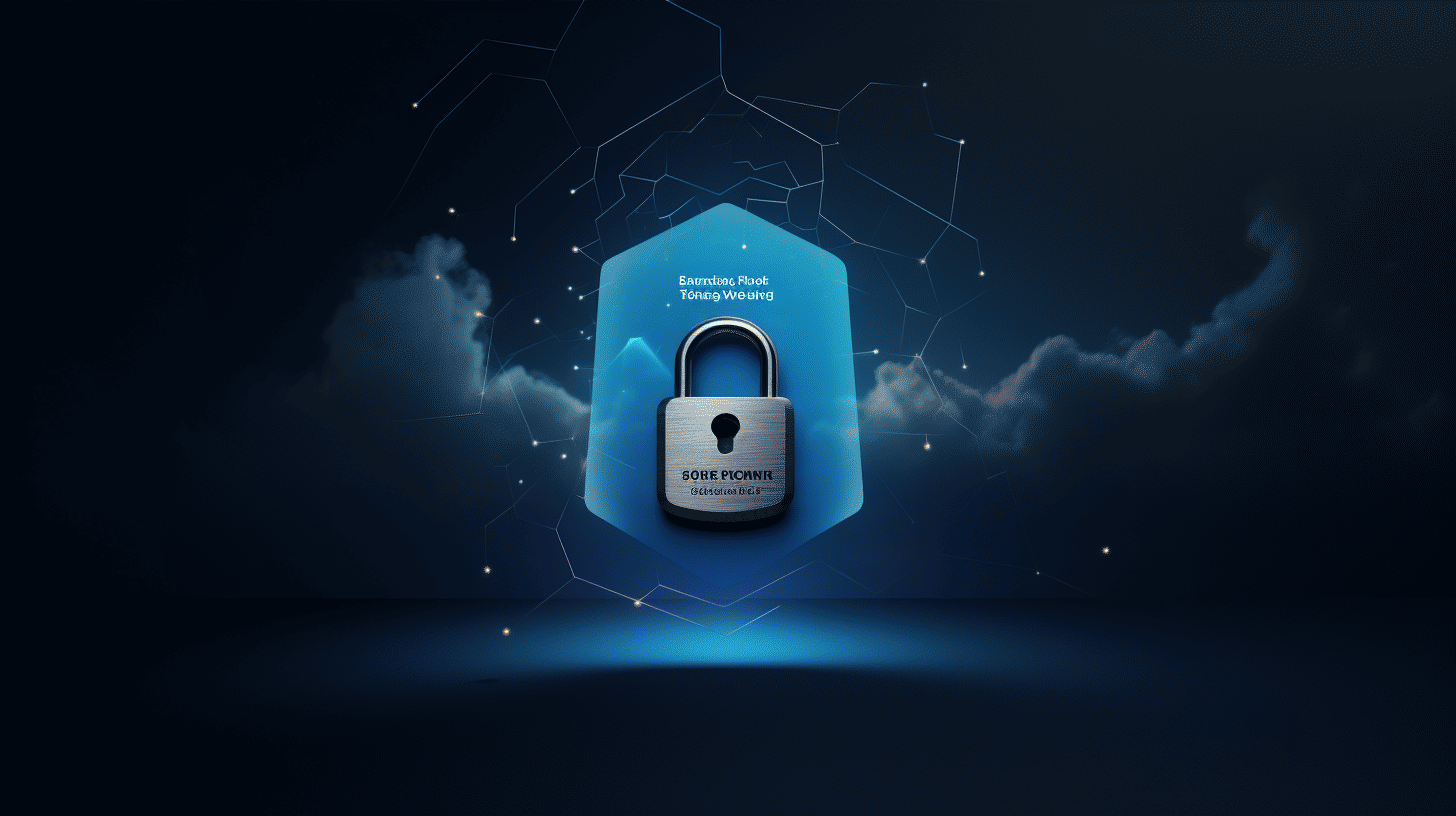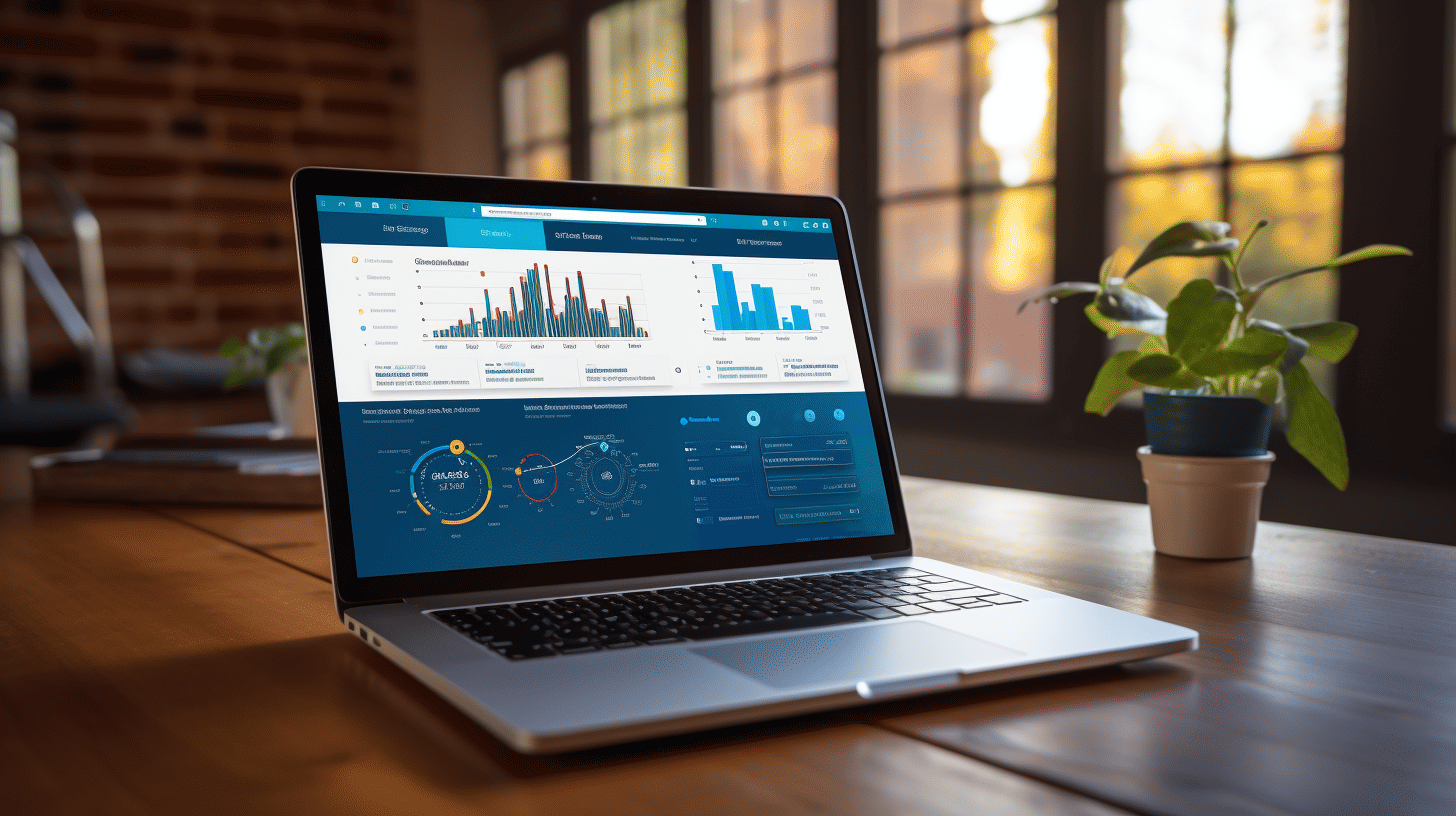在當今數位時代,擁有強大的網路影響力對於小型企業來說至關重要。最受歡迎的網站建立平台之一是 WordPress。 WordPress 憑藉其用戶友好的介面和廣泛的自訂選項,已成為許多企業家的首選。然而,能力越大,責任越大。對於小型企業主來說,了解保護他們的 WordPress 投資免受潛在安全威脅的重要性至關重要。
🔒🔐🚀
在本文中,我們將探討確保您的 WordPress 網站安全並保護您寶貴資料的最佳做法。無論您是經驗豐富的 WordPress 使用者還是剛起步的新手,這些技巧都將幫助您加強網站防禦駭客、惡意軟體和其他潛在安全風險。
因此,讓我們深入研究並發現確保 WordPress 網站的安全性和長久性所需採取的關鍵步驟。從保持您的 WordPress 核心、主題和外掛程式更新到實施雙重認證和保護您的管理區域,我們將涵蓋所有內容。閱讀本文後,您將掌握保護 WordPress 投資和為您的小型企業提供應有安全保障所需的知識和工具。 🛡️💼
保持 WordPress 核心、主題和外掛程式更新的重要性
在當今的數位環境中,擁有一個安全的網站至關重要。隨著網路威脅和駭客攻擊的不斷增加,確保您的網站和其所保存資料的安全性比以往任何時候都更加重要。保護 WordPress 網站的一個有效方法是定期更新其核心、主題和外掛程式。
為什麼更新很重要?
過時的軟體可能會使您的網站容易受到駭客攻擊。駭客一直在尋找 WordPress 等流行平台中的漏洞以供利用。當開發人員發現並修復這些漏洞時,他們會發布更新來修補它們。透過保持 WordPress 核心、主題和外掛程式為最新版本,您可以確保擁有最新的安全修補程式並防禦新出現的威脅。
強調更新重要性的統計數據
根據最近的 WordPress 漏洞報告,大多數漏洞來自插件而不是核心本身。事實上,報告指出 97% 的漏洞來自插件,2.4% 來自主題,只有 0.05% 來自核心。這突顯了插件在網站安全中發揮的重要作用,並進一步強調了保持插件更新的重要性。
另一個令人震驚的統計數據是,2023 年全球有超過 7500 萬個 WordPress 網站遭到攻擊。
更新 WordPress 核心、主題和外掛的主要好處
定期更新 WordPress 核心、主題和外掛程式可帶來以下好處:
- 增強安全性:更新通常包括解決漏洞的關鍵安全性修補程式。透過保持更新,您可以降低網站被駭客入侵的風險。
- 提高性能:更新不僅可以解決安全性問題,還可以增強您網站的整體效能。它們可能包括錯誤修復、優化和可以提高您網站的功能和速度的新功能。
- 相容性:更新確保與最新版本的 WordPress 和其他外掛程式相容。這有助於防止衝突並確保您的網站順利運作。
- 存取新功能:更新通常會引入新功能和功能,以增強您網站的使用者體驗。透過定期更新,您可以利用這些新功能並保持競爭優勢。
- 支援和維護:透過保持最新狀態,您更有可能獲得來自開發人員和 WordPress 社群的支援和幫助。舊版的軟體通常不再受支援,這使得解決問題變得困難。
結論
更新您的 WordPress 核心、主題和外掛是維護您網站安全性和功能的重要步驟。透過保持最新狀態,您可以降低安全漏洞的風險,提高效能,確保相容性並獲得新功能。所以,不要忽視這些更新通知——它們可能是確保您的網站安全和順利運行的關鍵。
閱讀更多關於 WordPress 漏洞報告 了解有關保護 WordPress 網站安全的最新安全趨勢和建議。
使用 SSL/TLS 憑證保護使用者數據
🔒 在當今數位時代,確保用戶資料的安全和隱私至關重要。隨著網路威脅和網路攻擊的不斷增加,企業需要採取主動措施來保護敏感資訊。其中一項措施是使用 SSL/TLS 憑證。
🔐 SSL(安全通訊端層)及其後繼 TLS(傳輸層安全性)是提供網際網路上資料通訊加密和身分驗證的加密協定。透過使用 SSL/TLS 證書,企業可以在其網站和使用者瀏覽器之間建立安全連接,建立信任並保護傳輸資料的機密性。
⭐ SSL/TLS 憑證是強大安全性策略的重要組成部分。以下是它們對於保護用戶資料至關重要的一些原因:
1. 資料加密
🔐 當網站上安裝了 SSL/TLS 憑證後,它會透過加密伺服器和使用者瀏覽器之間傳輸的資料來實現安全通訊。這種加密確保即使資料被惡意行為者截獲,他們也無法理解和使用。
2. 網站認證
🔒 SSL/TLS 憑證也可以作為驗證網站身分的一種手段。它們向用戶保證,他們正在與目標網站進行交互,而不是與詐騙網站進行交互。對於處理敏感資訊(例如登入憑證、財務詳細資訊或個人資訊)的網站來說,這一點尤其重要。
3. 信任與信心
🔑 透過在瀏覽器的網址列中顯示掛鎖符號和 HTTPS 協議,SSL/TLS 憑證可以贏得使用者的信任和信心。這表明該網站已採取措施保護他們的資料並提供安全的瀏覽體驗。相較之下,沒有 SSL/TLS 憑證的網站可能會被現代瀏覽器標記為不安全,導致用戶在分享任何資訊之前猶豫不決。
4. 遵守資料保護法規
🔒 處理使用者資料(尤其是個人識別資訊(PII))的企業必須遵守各種資料保護法規,例如《一般資料保護規範》(GDPR)或《加州消費者隱私法案》(CCPA)。實施 SSL/TLS 憑證通常是滿足這些合規性要求和保護使用者隱私的必要步驟。
5.提高搜尋引擎排名
🚀 除了安全優勢之外,SSL/TLS 憑證還具有 SEO 優勢。像 Google 這樣的搜尋引擎會優先考慮有 HTTPS 的網站,而不是沒有 HTTPS 的網站。因此,擁有 SSL/TLS 憑證可以對網站的搜尋引擎排名產生正面影響,讓網站更容易被搜尋相關關鍵字的使用者看到。
🔒總之,SSL/TLS 憑證在保護使用者資料和建立線上信任方面發揮著至關重要的作用。透過加密資料、驗證網站和提供安全的瀏覽體驗,企業可以保護敏感資訊並遵守資料保護法規。此外,憑藉其提供的 SEO 優勢,SSL/TLS 憑證已成為維持強大線上形象的重要組成部分。
安全 WordPress 託管提供者的優勢
在當今的數位環境中,網站安全至關重要。隨著網路威脅變得越來越複雜和普遍,企業必須優先確保其線上業務的安全。網站安全的關鍵方面是選擇可靠且安全的 WordPress 託管服務提供者。在本節中,我們將探討選擇安全的 WordPress 託管服務提供者的好處以及他們如何保護您的網站免受潛在風險。
防火牆
安全的 WordPress 託管服務提供者的顯著優勢之一是實施強大的防火牆。防火牆可作為您的網站和潛在威脅之間的屏障,確保只有合法流量可以通過。這些先進的安全措施可以幫助保護您的網站免受駭客、惡意軟體和其他惡意活動的侵害。有了安全的 WordPress 主機服務供應商,您可以放心,因為您的網站受到強大的防火牆的保護,可以持續監控和過濾傳入流量。
惡意軟體掃描
安全的 WordPress 託管服務提供者的另一個主要優勢是包含定期惡意軟體掃描。惡意軟體是指可能感染您的網站並危害其安全的惡意軟體,例如病毒或間諜軟體。安全的 WordPress 託管服務提供者採用複雜的掃描工具來偵測並消除您網站上的惡意軟體。透過定期掃描惡意軟體,這些提供者可確保您的網站保持乾淨和安全,最大限度地降低資料外洩或未經授權存取敏感資訊的風險。
定期備份
意外時有發生,有時網站可能會因硬體故障、人為錯誤或網路攻擊而遭受資料遺失。這是安全的 WordPress 託管提供者真正閃耀光芒的地方。他們通常會定期備份您的網站,以確保您在緊急情況下擁有資料的副本。透過這些備份,如果出現任何不可預見的問題,您可以快速將您的網站還原到以前的狀態。定期備份是無價的安全網,可保護您的業務免受重大中斷和潛在的寶貴資料遺失。
透過選擇安全的 WordPress 主機服務供應商,您可以受益於防火牆、惡意軟體掃描和定期備份等進階安全措施。這些提供者優先考慮您網站的安全,讓您專注於經營業務,而不必擔心潛在的網路威脅。憑藉其專業知識和對保護您線上形象的承諾,安全的 WordPress 託管服務提供者對於任何企業主來說都是一項必不可少的投資。
要了解有關為您的企業選擇合適的託管 WordPress 託管解決方案的更多信息,請查看我們的 安全的 WordPress 託管提供者文章.
強密碼和限制登入嘗試
在當今的數位環境中,保護我們的個人資訊安全比以往任何時候都更加重要。保護我們的線上帳戶的最簡單和最有效的方法之一是使用強密碼並限制登入嘗試次數。這不僅保護了我們的敏感數據,而且還防止未經授權存取我們的帳戶。讓我們深入探討這些安全措施為何至關重要以及如何實施它們。
強密碼的重要性
🔒 強密碼可以作為防禦手段,抵禦那些不斷尋找弱密碼進行攻擊的駭客和網路犯罪分子。它就像一道幾乎堅不可摧的屏障,保護著我們的個人和財務資訊。以下是強密碼至關重要的幾個主要原因:
- 防止暴力攻擊: 強密碼使駭客更難透過暴力攻擊來未經授權存取我們的帳戶,他們會系統地嘗試不同的組合,直到找到正確的密碼。
- 降低與密碼相關的風險: 弱密碼,例如常用單字、容易猜到的組合(例如「123456」)或個人資訊,可能會使我們的帳戶面臨風險。包含大寫和小寫字母、數字和符號的強密碼可大幅降低未經授權存取的可能性。
- 防範憑證填充: 憑證填充是一種技術,駭客使用從其他資料外洩中竊取的使用者名稱和密碼組合來未經授權存取其他帳戶。每個帳號獨有的強密碼有助於防止憑證填入攻擊的成功。
實施強密碼
創建一個強密碼一開始可能看起來很困難,但它值得付出努力。以下提示可協助您設定一個既強大又容易記住的密碼:
- 使用大寫和小寫字母、數字和符號的組合。
- 避免使用容易猜到的訊息,例如您的姓名、出生日期或最喜歡的運動隊伍。
- 選擇較長的密碼,因為它們通常更安全。
- 考慮使用密碼短語而不是單字,將幾個容易記住但別人難以猜測的單字組合在一起。
請記住,密碼的強度對您的帳戶的安全性有很大影響。花點時間為你的每個線上帳戶建立獨特而強大的密碼,以最大程度地防止未經授權的存取。
限制登入嘗試
🛡️限制登入嘗試次數是增強帳戶安全性和阻止未經授權存取的另一種有效方法。透過設定登入失敗次數的限制,我們可以阻止潛在的攻擊者嘗試無數種組合直到找到正確的密碼。這就是為什麼這個簡單的措施如此有效:
- 阻止暴力攻擊: 透過對登入嘗試次數實施限制,我們可以大幅增加駭客透過暴力攻擊破解我們密碼的難度。經過一定次數的失敗嘗試後,該帳戶將被鎖定或暫時停用,這使得惡意行為者極難獲得存取權限。
- 防止自動攻擊: 許多駭客攻擊都是使用自動化軟體進行的,該軟體會快速嘗試不同的密碼組合。限制登入嘗試次數可有效地抵禦這些自動攻擊,方法是在預定的失敗嘗試次數後阻止存取。
- 提醒我們注意可疑活動: 如果我們收到有關多次登入失敗的通知,則它可以作為潛在未經授權的存取嘗試的早期預警信號。這使我們能夠立即採取行動,例如更改密碼和加強安全措施。
實施登入嘗試限制可能會因所使用的平台或服務而異。一些常見的策略包括:
- 設定暫時鎖定之前的最大登入嘗試次數。
- 在連續登入嘗試之間實施延遲,以減緩暴力攻擊。
- 利用多因素身份驗證來增加額外的安全層。
透過限制登入嘗試次數,我們大大降低了成功進行暴力攻擊和未經授權存取我們帳戶的風險。
🔑 總而言之,強密碼和限制登入嘗試是強大的線上安全策略的重要組成部分。透過採取這些措施,我們可以更好地保護我們的個人資訊、財務資源和線上身分免受網路威脅。請記住,花一點時間和精力創建強密碼可以大大保證您的帳戶安全。透過實施這些簡單但有效的安全措施,領先駭客一步!
定期掃描網站以查找惡意軟體和安全性問題
🔒 保護您的網站:定期掃描的重要性
在當今的數位環境中,網站安全至關重要。網路威脅日益增加,各種規模的線上企業都有可能成為惡意軟體攻擊的受害者。但不要害怕!透過實施定期的網站掃描實踐,您可以加強您的線上形象並阻止惡意行為者。
🔍 什麼是網站掃描?
網站掃描包括系統地檢查您的網站是否有任何漏洞或惡意軟體跡象。這是透過及時識別和解決安全問題來保護您的線上平台的主動方法。透過定期掃描,您可以領先潛在威脅一步,並採取適當的措施來保護您的網站及其訪客。
🛡️ 定期網站掃描的好處
定期網站掃描有許多好處,不僅僅是保障您的線上狀態。以下是您應該優先考慮此事項的幾個原因:
- 檢測並消除惡意軟體:掃描可以發現隱藏的惡意軟體、惡意程式碼注入或可能危害您網站完整性的可疑檔案。透過識別這些威脅,您可以快速將其刪除並防止對您的網站及其訪客造成任何損害。
- 保護用戶數據:您的網站可能會收集用戶的敏感信息,例如個人資料或付款詳細資訊。定期掃描可確保資料的安全,降低未經授權的存取或資料外洩的風險。
- 維護搜尋引擎聲譽:像谷歌這樣的搜尋引擎優先考慮安全的網站,並給予它們更高的搜尋排名。透過定期掃描您的網站,您可以展示您對安全的承諾,提高您的 SEO 效能,並吸引更多的自然流量。
- 增強使用者信任:隨著網路安全問題日益突出,使用者在瀏覽網頁時變得更加謹慎。透過定期掃描表明您優先考慮網站安全,您可以讓訪客充滿信心並建立對您品牌的信任。
- 保持合規:根據您的行業,您可能需要遵守某些安全法規和標準。定期網站掃描可協助您確保遵守這些要求,避免潛在的處罰和聲譽損害。
🔧 實施定期網站掃描
若要充分利用定期網站掃描,請按照以下步驟操作:
- 選擇可靠的網站安全解決方案:選擇具有全面掃描功能的知名網站安全工具。尋找惡意軟體偵測、漏洞評估和即時監控等功能。
- 安排自動掃描:設定定期掃描計劃,以確保對您的網站進行持續監控。這將幫助您及時發現任何安全問題並防止潛在風險升級。
- 查看掃描結果:掃描完成後,仔細檢查結果以識別任何漏洞或惡意軟體偵測。立即採取行動解決這些問題以維持安全的環境。
- 保持更新:使用最新的安全性修補程式和更新確保您的網站和所有相關軟體保持最新。定期檢查新的威脅和漏洞,以防範新出現的風險。
💡 結論
在日益互聯互通的世界裡,網站安全應該成為所有企業的首要任務。定期網站掃描是保護您的線上平台、使用者資料和品牌聲譽的關鍵步驟。透過實施正確的安全措施並進行例行掃描,您可以加強您的數位存在並領先網路威脅一步。不要讓惡意軟體和安全問題危害您的業務—立即開始掃描!
啟用雙重認證 (2FA) 以增強安全性
在當今的數位環境中,個人資訊和線上帳戶遭受洩露的風險越來越大,採取主動措施保護自己至關重要。其中一項措施是啟用雙重認證 (2FA)。 🛡️✨
什麼是雙重認證 (2FA)?
雙重認證(也稱為 2FA)是額外的安全層,有助於保護您的線上帳戶。它為登入過程增加了一個額外的步驟,確保即使有人掌握了您的密碼,他們也無法在沒有第二重驗證的情況下存取您的帳戶。 📲🔒
雙重身份驗證如何運作?
當您啟用 2FA 時,登入流程將變成兩步驟驗證流程。讓我們仔細看看它是如何運作的:
- 步驟 1:密碼:您照常輸入使用者名稱和密碼。
- 第 2 步:第二重因素:成功輸入密碼後,系統會提示您提供第二種驗證形式。這可以是透過簡訊發送到您的行動裝置的唯一代碼、由身份驗證器應用程式產生的代碼,甚至是指紋或臉部辨識等生物特徵資料。
透過要求使用多種因素進行身份驗證,2FA 提供了額外的安全層,降低了未經授權存取您的帳戶的風險。 💪🔐
啟用雙重認證的好處
啟用 2FA 有許多好處,包括:
- 增強安全性:有了 2FA,即使有人設法獲取您的密碼,他們也將無法在沒有第二個身份驗證因素的情況下登入。這增加了一層額外的保護以防止未經授權的存取。
- 跨多裝置保護:2FA 可以設定為在各種裝置上工作,例如手機、平板電腦或電腦。無論您使用什麼裝置存取您的帳戶,這都可以確保您的帳戶保持安全。
- 防禦網路釣魚攻擊:網路釣魚攻擊是指攻擊者誘騙您在虛假網站上提供登入憑證的攻擊,這種攻擊可以透過 2FA 來阻止。即使攻擊者透過網路釣魚嘗試取得您的密碼,他們也沒有第二個因素來存取您的帳戶。
- 安心:啟用 2FA 可讓您高枕無憂,因為您知道您的帳戶已獲得額外的安全保障。您可以放心,您的敏感資訊受到了更好的保護。
如何為您的帳戶啟用雙重認證
啟用 2FA 的流程可能會因您使用的平台或服務而有所不同。但是,啟用 2FA 的一般步驟如下:
- 步驟 1:找到安全設定:進入您想要保護的平台或服務的安全設定。尋找與雙重認證或帳戶安全相關的選項。
- 第 2 步:選擇第二個因素:選擇您喜歡的第二種身份驗證方法。這可以透過簡訊接收代碼、使用身份驗證應用程式、甚至是生物識別身份驗證。
- 步驟 3:依照設定流程操作:請按照螢幕上的指示設定第二個身份驗證因素。這可能涉及連結您的手機號碼、掃描二維碼或配置您的設定。
請記得儲存備份代碼,以防您無法存取主要身份驗證因素。如有必要,可以使用這些備用代碼存取您的帳戶,因此請將其保存在安全的地方。
結論
啟用雙重認證 (2FA) 可為您的線上帳戶增加額外的安全層,並有助於保護您的敏感資訊免遭未經授權的存取。透過要求多種形式的驗證,2FA 提供了增強的安全性和安心感。花點時間為你的帳戶啟用2FA,並加強你的數位防禦! 🔒✨
WordPress 網站的定期備份
保護您的網站:定期備份的重要性
想像一下:您花了無數的時間來創建和完善您的 WordPress 網站。這是您的驕傲和喜悅,您的網路傑作。但如果有一天災難降臨了呢?您的網站遭到駭客攻擊,或是您意外刪除了重要檔案。你所有的辛苦,瞬間化為泡影。 😱
這就是定期備份的作用所在。它確保在災難發生時,您可以輕鬆地將您的網站恢復到以前的輝煌。在本節中,我們將探討定期備份的重要性以及為什麼應該優先考慮它們。
忽視備份的後果
🌪️如果沒有定期備份,你的 WordPress 網站很容易受到各種風險的攻擊:
- 資料遺失:如果您的網站的文件或資料庫損壞或意外刪除,您可能會遺失寶貴的內容、客戶資訊或重要設定。
- 安全漏洞:駭客總是在尋找網站中的漏洞。如果沒有備份,從受損的站點恢復將會非常困難。
- 外掛或主題衝突:有時,錯誤的外掛程式或主題更新可能會破壞您的網站。如果沒有備份,還原到工作版本就會變得更加困難。
定期備份的好處
✅ 定期備份你的 WordPress 網站有幾個好處:
- 安心:知道您有最近的備份可以依靠,這可以減輕潛在災難的壓力。
- 輕鬆恢復:透過備份,您可以快速將您的網站還原到先前的狀態或還原遺失的特定檔案或資料。
- 節省時間和成本:如果沒有備份,您可能需要花費大量時間和資源從頭開始重建您的網站。定期備份可以減輕您的這個負擔。
WordPress 備份的最佳實踐
🔒為確保您得到充分保護,請遵循以下 WordPress 備份最佳做法:
- 自動化流程:安排定期自動備份,這樣您就不必依賴很容易被忘記的手動備份。
- 異地儲存備份:將您的備份保存在安全的異地位置,與您的 WordPress 託管伺服器分開。這樣,即使您的伺服器崩潰,您仍然可以存取您的備份。
- 測試您的備份:定期測試復原過程以確保您的備份正常運作。最好在陷入危機之前發現備份中存在的任何問題。
- 考慮使用具有備份服務的外掛程式或 Web 主機:有許多外掛程式和網站主機提供專為 WordPress 網站量身打造的備份服務。探索這些選項以簡化備份過程。
結論
🔑 不要等到為時已晚才保護您的 WordPress 網站。定期備份對於保護您的辛勤工作成果和確保您的線上狀態保持完整至關重要。透過實施備份策略並遵循最佳實踐,您可以放心,如果發生意外,您將準備好快速恢復並比以往更強大。
使用外掛保護 WordPress
🔒 在當今的數位環境中,確保 WordPress 網站的安全至關重要。隨著網路威脅日益普遍,採取主動措施保護您的網站免受潛在駭客和攻擊者的攻擊至關重要。強化 WordPress 網站的一個有效方法是利用安全外掛。這些外掛程式提供了一系列特性和功能,旨在增強您網站的安全性並保護其免受惡意活動的侵害。在本文中,我們將探討兩個流行的 WordPress 安全性外掛:Wordfence 和 Sucuri。
字柵欄
說到 WordPress 安全插件,Wordfence 無疑是最受信任和最廣泛使用的選項之一。 Wordfence 擁有超過 400 萬個活躍安裝,提供了一套全面的安全工具來保護您的 WordPress 網站。以下是 Wordfence 的一些主要功能:
- Web 應用程式防火牆 (WAF): Wordfence 擁有強大的 WAF,可主動監控和過濾傳入流量以識別和封鎖惡意活動。它分析網站流量模式並識別潛在威脅,提供針對駭客、機器人和其他惡意實體的即時保護。
- 惡意軟體掃描: Wordfence 會定期掃描您的 WordPress 網站以偵測任何惡意軟體或可疑檔案。它會檢查核心文件、主題和插件,確保您的網站不存在潛在的安全漏洞。
- 登入安全: 使用 Wordfence,您可以實施強大的登入安全措施,例如雙重認證 (2FA) 和強密碼強制執行。這些功能增加了額外的保護層,以防止未經授權存取您的 WordPress 管理區域。
蘇庫裡
WordPress 的另一個備受推崇的安全性外掛是 Sucuri。 Sucuri 專注於網站安全,並提供針對各種線上威脅的全面保護。以下是 Sucuri 的一些值得注意的特點:
- 網站防火牆: Sucuri 的網站防火牆 (WAF) 可作為您的 WordPress 網站與潛在攻擊者之間的盾牌。它攔截並過濾惡意請求,確保只有合法流量到達您的網站。這有助於防止駭客攻擊和暴力攻擊。
- 惡意軟體清理: 如果您的 WordPress 網站不幸感染了惡意軟體,Sucuri 可以幫助您清理混亂局面。他們的安全專家團隊將掃描您的網站,刪除任何惡意軟體,並將其恢復到乾淨、安全的狀態。
- 安全通知: Sucuri 透過發送有關您的 WordPress 網站的潛在威脅的即時安全通知,讓您隨時了解情況。這使您可以立即採取行動並及時解決任何安全問題。
Wordfence 和 Sucuri 都提供了出色的安全功能,但值得一提的是,同時使用多個安全性外掛程式可能會出現相容性問題並影響網站的效能。建議選擇一個符合您的特定安全需求的插件並堅持使用它。
🔐 實施強大的安全性外掛程式是保護您的 WordPress 網站免受潛在威脅的主動步驟。透過使用 Wordfence 或 Sucuri 等插件,您可以增強網站的整體安全性、保護敏感資料並為訪客提供安全的瀏覽體驗。不要讓您的 WordPress 網站的安全性處於危險之中 – 立即採取行動!
實施防火牆保護
在我們生活的快節奏的數位世界中,網路安全至關重要。隨著網路威脅的不斷增加,保護您的線上資產已成為必需。防火牆是網路安全武器庫中不可或缺的工具之一。
防火牆充當電腦網路與外界之間的屏障,監控和控制傳入和傳出的網路流量。它有助於將不需要的和潛在有害的流量排除在您的系統之外,同時允許安全和合法的流量通過。
以下是實施防火牆保護的一些主要好處:
1.網路安全
防火牆是防止未經授權存取您的網路的第一道防線。透過過濾傳入的流量,它們可以阻止惡意駭客進入您的系統並洩漏敏感資料。他們還可以阻止流向可疑或黑名單目的地的出站流量,從而防止潛在的資料外洩。
2.入侵防禦
防火牆可以偵測並阻止未經授權的存取嘗試,例如連接埠掃描和暴力攻擊。他們分析網路流量模式並將其與預先定義的安全規則進行比較以識別可疑活動。如果偵測到入侵嘗試,防火牆可以立即採取行動,封鎖來源 IP 位址或警告網路管理員。
3. 應用程式控制
防火牆還可以對可存取網路的應用程式提供精細的控制。透過設定基於應用程式的規則,您可以決定哪些軟體被允許與外界通訊。這有助於防止惡意軟體的傳播並限制潛在的安全漏洞。
4.內容過濾
防火牆可用於執行內容過濾策略,阻止存取特定網站或特定類型的內容。這在公司環境中特別有用,可以防止員工造訪可能帶來安全風險或分散其工作職責的網站。
5.安全遠端存取
如果您的企業允許遠端存取內部資源,則防火牆在保護這些連線方面可以發揮至關重要的作用。透過實施虛擬私人網路 (VPN) 技術,防火牆可以為遠端使用者建立安全隧道以存取您的網路資源,同時保持他們的通訊加密和保護。
實施防火牆保護解決方案是保護您的網路和敏感資料免受網路威脅的重要一步。若要了解如何有效實施防火牆保護,請查看此內容 綜合指南 關於防火牆的實施和最佳實務。注意安全! 🔒
刪除未使用的主題和插件
📸 捕捉您網站的精髓:刪除未使用的主題和外掛程式!
在管理網站時,有時少即是多。隨著網站的發展,您可能會發現自己累積了大量不再有用的主題和外掛程式。這些未使用的資源會使您的網站混亂,降低其效能,甚至帶來安全風險。現在是時候透過刪除這些未使用的主題和外掛程式來整理和優化您的網站了!
為什麼要刪除未使用的主題和外掛?
- 提高網站效能: 您網站上的每個主題和外掛程式都會增加一些開銷,從而影響您網站的速度和整體效能。刪除未使用的主題和外掛程式可以減輕這種負擔,從而加快訪客的載入時間。
- 增強安全性: 未使用的主題和外掛程式是駭客和惡意行為者的潛在入口點。透過卸載它們,您可以減少攻擊面並最大限度地降低您的網站受到攻擊的風險。
- 簡化的網站管理: 透過減少需要更新的主題和插件,您將獲得更簡化的管理體驗。您可以將精力集中在推動網站成功的關鍵要素上。
- 增強穩定性: 外掛程式和主題相互交互,並與您網站的核心文件互動。它們之間的不相容性可能會導致錯誤、崩潰,甚至死機白屏。透過消除未使用的資源,您可以最大限度地減少相容性問題的可能性並創建更穩定的網站環境。
如何刪除未使用的主題和插件
- 🏗️ 評估您的網站: 首先對您目前的主題和外掛程式進行全面盤點。確定您不再使用或需要哪些。注意它們提供的任何特定功能,並確定是否有合適的替代品或內建功能可以取代它們。
- 🧹 停用並刪除: 一旦您確定了未使用的主題和插件,就該從您的網站停用並刪除它們。您可以按照以下方式操作:
- 主題: 導覽至您的 WordPress 儀表板,前往「外觀」→「主題」。將滑鼠懸停在要刪除的主題上,然後按一下「主題詳細資料」按鈕。在右下角,您會找到“刪除”選項。確認刪除,主題將從您的網站永久刪除。
- 插件: 從您的 WordPress 儀表板,前往「外掛程式」→「已安裝的外掛程式」。找到您要刪除的插件,然後點擊其名稱下方的「停用」連結。一旦停用,就會出現「刪除」選項。點擊它將從您的網站中刪除該插件。
- 🧪 測試您的網站: 刪除未使用的主題和外掛程式後,測試您的網站是否有任何意外問題或錯誤至關重要。確保網站的佈局、功能和效能保持完整。
保持網站整潔、繁榮
透過刪除未使用的主題和插件,您不僅可以優化網站的效能,還可以增強其安全性並簡化您的管理任務。告別不必要的臃腫,迎接精簡有效率的網站。今天就開始清理,讓您的網站的精髓閃耀光芒!請記住,整潔的網站才是蓬勃發展的網站。 🌟
定期更新修補程式安全漏洞
在當今的數位環境中,網路威脅不斷演變,主動保護您的系統和資料免受惡意行為者的攻擊至關重要。最有效的方法之一是定期更新軟體和作業系統以修補安全漏洞。
透過保持最新更新,您可以確保您的系統能夠抵禦最新的威脅和入侵。以下是定期更新以修補安全漏洞應成為首要任務的幾個令人信服的理由:
- 保持領先一步: 網路犯罪分子不斷尋找軟體和作業系統中的漏洞以供利用。透過定期更新,您可以領先一步,在攻擊者利用之前關閉潛在的入口點。
- 防範已知漏洞: 軟體供應商和安全研究人員正在不斷發現和解決安全漏洞。更新通常與專門用於修復這些漏洞、防止潛在攻擊的修補程式捆綁在一起。
- 增強系統效能: 更新不僅解決安全性問題,還通常包括效能增強和錯誤修復。透過定期更新,您可以確保您的系統平穩且有效率地運作。
- 保持合規性: 許多行業法規(例如 PCI DSS 或 GDPR)要求組織使用最新的安全性修補程式來保持其係統保持最新。透過定期更新,您可以繼續遵守這些標準並避免潛在的罰款或其他處罰。
為了讓更新過程更順暢、更少中斷,請考慮以下提示:
- 自動更新: 盡可能啟用自動更新,以確保您的軟體和作業系統不斷修補,而無需不斷的人工幹預。
- 確定關鍵系統的優先順序: 識別並確定儲存敏感資料或直接連接到互聯網的關鍵系統或應用程式的優先順序。首先要專注於保持這些系統的更新,以盡量減少您的風險敞口。
- 測試更新: 在整個組織推出軟體更新之前,在受控環境中對其進行測試至關重要。這有助於識別可能影響系統穩定性的任何相容性問題或意外問題。
- 教育用戶: 提高員工對定期更新軟體和作業系統的重要性的認識。鼓勵他們及時在個人裝置上安裝更新,以最大限度地降低潛在的安全風險。
請記住,定期更新以修補安全漏洞是一個持續的過程。網路威脅不斷演變,軟體供應商也不斷發布新的修補程式來解決新出現的漏洞。透過保持警覺和積極主動,您可以顯著降低遭受網路攻擊的風險並確保系統和資料的安全。
⚠️ 請記得定期備份您的數據,以防止在更新過程中出現意外問題而造成任何損失。
具有唯一存取憑證的管理區域安全性
🔒簡介:保護網站的管理區域對於確保系統的整體安全至關重要。增強這種安全性的一個有效方法是針對管理區域實施唯一的存取憑證。透過要求管理員具有不同的登入憑證,您可以顯著降低未經授權的存取和潛在安全漏洞的風險。
唯一存取憑證的重要性
擁有管理區域的唯一存取憑證有幾個好處,包括:
- 🛡️ 增強安全性:透過為每位管理員提供唯一的使用者名稱和密碼,您可以為您的管理區域添加額外的保護層。這使得入侵者更難獲得未經授權的訪問,從而降低資料外洩和惡意活動的風險。
- 🗝️ 責任制:當每個管理員都有自己的一組憑證時,追蹤和識別使用者操作變得更加容易。如果發生任何可疑活動,更容易找出責任方並採取適當的行動。
- 💪 細粒度的權限:透過唯一的存取憑證,您可以為每個管理員指派特定的權限和特權。這使您可以控制對敏感區域的訪問,並將某些操作限制為僅限授權人員。
實施唯一存取憑證
為了確保唯一存取憑證的有效性,請考慮以下最佳做法:
- 📝 使用強密碼:鼓勵管理者建立包含數字、字母(大寫和小寫)和特殊字元組合的複雜密碼。避免使用常用字詞或容易猜到的訊息,如生日或寵物名字。
- 👥 啟用多因素身份驗證:實施多因素身份驗證可增加一層額外的安全性,要求管理員除了提供密碼之外還提供額外的驗證,例如發送到其行動裝置的唯一代碼。這大大降低了未經授權存取的風險。
- 🔒定期更新憑證:定期更新存取憑證至關重要,以減輕因密碼外洩而導致未經授權存取的可能性。制定策略強制定期更改密碼並提前通知管理員。
結論
使用唯一的存取憑證保護管理區域是保護網站或系統的基本步驟。透過實施這額外的安全層,您可以保護寶貴的資料、確保責任並保持對系統權限的精細控制。在設定和管理存取憑證時,請記住遵循最佳實踐,以最大限度地提高其有效性。
將 wp-config.php 移出根資料夾以增加保護
🔐 在保護你的 WordPress 網站時,你需要注意的一個關鍵文件是 wp-config.php。該文件包含敏感信息,例如您的資料庫憑證、身份驗證金鑰和其他重要配置設定。如果駭客獲得此文件的存取權,他們將對您的網站造成嚴重破壞。
🛡️ 幸運的是,你可以採取一個簡單但有效的步驟來增強你的 wp-config.php 檔案:將其移出根資料夾。這樣做可以使未經授權的使用者更難找到和存取這個關鍵文件。
📂 但移動 wp-config.php 文件在根資料夾之外?那你該如何做呢?讓我們深入了解一下細節:
為什麼要搬家 wp-config.php 在根資料夾之外?
🔒 WordPress 安裝的根資料夾通常是儲存您網站的主檔案和資料夾的地方。預設情況下, wp-config.php 文件位於此位置。不幸的是,如果駭客知道文件的儲存位置,他們就可以輕易地對其進行未經授權的存取。
💡 搬家 wp-config.php 根資料夾外面為您的 WordPress 網站添加了額外的保護層。當檔案放在非公開可存取的目錄中時,攻擊者找到並利用它會變得更具挑戰性。
如何移動 wp-config.php 根資料夾之外
⚙️ 移動 wp-config.php 文件涉及幾個簡單的步驟。以下逐步指南可協助您完成整個過程:
- 備份您的
wp-config.phpfile: 在進行任何更改之前,最好先備份您的wp-config.php文件。這可確保在出現任何問題時您擁有原始文件的副本。 - 建立新目錄: 在 WordPress 安裝的根資料夾之外建立一個新目錄。考慮賦予它一個不容易猜到的獨特名稱。
- 移動
wp-config.phpfile: 使用檔案總管或 FTP 用戶端,將wp-config.php檔案從根資料夾複製到剛剛建立的新目錄。 - 更新 WordPress 安裝中的檔案路徑: 現在你已經移動了
wp-config.php文件,您需要更新 WordPress 安裝中的文件路徑。打開索引.php在 WordPress 安裝的根資料夾中建立一個文件,並在頂部添加以下程式碼行:
需要(目錄名(__FILE__)。'/new-directory-name/wp-config.php');
代替 新目錄名稱 替換為您在步驟 2 中建立的目錄的名稱。
- 驗證更改: 要確認一切正常,請訪問您的網站並確保其按預期運作。如果出現任何問題,您可以透過恢復備份來還原更改
wp-config.php文件。
🔑 透過遵循以下步驟,您可以有效地移動 wp-config.php 文件位於根資料夾之外,為您的 WordPress 網站提供額外的安全性。
🚨 請記得採取其他安全措施,例如使用強密碼、保持 WordPress 及其外掛程式/主題為最新版本,以及定期備份您的網站以進一步保護您的線上狀態。
實作 HTTP 驗證
🔒 使用 HTTP 驗證保護您的 Web 應用程式
在當今數位時代,確保您的 Web 應用程式的安全比以往任何時候都更加重要。保護敏感資訊的一個非常有效的方法是實作 HTTP 驗證。透過要求使用者在存取您的網站或其中的某些區域之前提供有效的憑證,HTTP 身份驗證有助於保護您的資料免遭未經授權的存取。
🔐 HTTP 驗證的主要優點
實作 HTTP 驗證可為網站擁有者和使用者帶來一系列好處。讓我們來看看一些顯著的優勢:
- 增強安全性: HTTP 驗證為您的 Web 應用程式增加了額外的安全性層。透過要求使用者進行自我身份驗證,您可以有效地防止未經授權存取敏感資料和資源。
- 簡化的使用者管理: 透過 HTTP 驗證,管理使用者存取變得更加簡單。您可以利用 HTTP 協定的內建驗證功能,而不必依賴複雜的使用者管理系統。
- 靈活性: HTTP 驗證可讓您從不同的驗證方法中進行選擇,例如 Basic、Digest 甚至自訂驗證方案。這種靈活性使您能夠根據您的特定需求和要求自訂身份驗證流程。
- 與現有系統整合: HTTP 驗證可與現有系統無縫集成,使其更容易融入您的 Web 應用程式。無論您使用的是內容管理系統 (CMS) 還是定製網站,實作 HTTP 驗證通常都是一個簡單的流程。
🗝️ 如何實作 HTTP 驗證
實作 HTTP 身份驗證是一個相對簡單的過程。以下是幫助您入門的逐步指南:
- 選擇身份驗證方法: 確定哪種身份驗證方法最適合您的 Web 應用程式。基本驗證方法是最容易實現的,但摘要式和自訂方法提供了增強的安全性。
- 配置伺服器: 設定您的 Web 伺服器以啟用 HTTP 驗證。具體步驟將根據您使用的伺服器軟體(例如 Apache、NGINX)而有所不同。請參閱伺服器的文件以取得詳細說明。
- 建立使用者憑證: 產生用於身份驗證的必要使用者憑證(例如使用者名稱和密碼)。實施強密碼策略對於確保身分驗證過程的完整性至關重要。
- 設定存取控制: 定義 Web 應用程式中需要身份驗證的區域。這可以透過根據您的伺服器設定將存取控制規則套用至特定目錄、檔案或 URL 來實現。
⚠️ 牢記安全最佳實踐
雖然 HTTP 驗證提供了額外的安全層,但必須記住,它並不是萬無一失的解決方案。為了確保最高等級的安全性,請考慮以下最佳做法:
- 定期更新使用者憑證並鼓勵使用者也這樣做。
- 實施強密碼策略,包括最小長度要求、複雜性規則和密碼過期時間。
- 監控並記錄身份驗證嘗試以偵測潛在的攻擊。
- 使用 HTTPS 等安全通訊協定來防止竊聽和資料篡改。
🔒 使用 HTTP 驗證確保安全
透過實作 HTTP 驗證,您可以大幅增強 Web 應用程式的安全性,並保護您的敏感資訊免遭未經授權的存取。花時間了解可用的不同身分驗證方法,並遵循提及的最佳實踐,以確保採取最強大的安全措施。您的使用者將會感激這層額外的保護,而您也會安心地知道您的 Web 應用程式是安全的。
掃描 SQL 注入漏洞
在當今的數位環境中,網路安全至關重要。多年來造成嚴重損害的一個特殊漏洞是 SQL 注入。這種技術允許駭客利用網路應用程式中的弱點並獲得對敏感資料的未經授權的存取。為了降低這種風險,組織必須主動掃描其係統以尋找 SQL 注入漏洞。在本文中,我們將深入研究掃描 SQL 注入漏洞的過程,並討論此實踐對於維護安全數位環境的重要性。
為什麼要掃描 SQL 注入漏洞?
SQL 注入攻擊可能會為企業和個人帶來嚴重後果。透過利用 Web 應用程式中的漏洞,攻擊者可以操縱 SQL 查詢並獲取敏感資訊的存取權限、修改或刪除數據,甚至控制整個系統。成功的 SQL 注入攻擊的潛在後果包括:
- 洩露敏感客戶數據,包括個人資訊和財務信息
- 業務營運中斷,導致財務損失和聲譽受損
- 法律和監管後果,例如不遵守資料保護法
- 損害客戶信任並喪失商業機會
鑑於 SQL 注入攻擊可能造成的危害,組織必須採取主動措施來識別和糾正漏洞,以免其被利用。掃描 SQL 注入漏洞是此過程的重要部分。
如何掃描 SQL 注入漏洞
掃描 SQL 注入漏洞的過程涉及一種系統化的方法來識別潛在的弱點並在其被利用之前解決它們。進行 SQL 注入漏洞掃描時應遵循以下步驟:
- 評估應用前景: 了解您的組織內正在使用的 Web 應用程式和資料庫。識別關鍵系統並確定掃描優先順序。
- 使用Web應用程式漏洞掃描程式: 利用專門的工具掃描 Web 應用程式是否有漏洞,包括 SQL 注入。這些掃描器模擬攻擊以識別潛在漏洞並提供補救建議。
- 執行手動程式碼審查: 除了使用自動掃描工具外,對程式碼庫進行手動審查也是必不可少的。這涉及分析應用程式的原始程式碼以查找與 SQL 注入相關的任何潛在安全漏洞。
- 實施安全最佳實務: 確保在開發 Web 應用程式期間遵循安全編碼實務。實施輸入驗證、參數化查詢和其他業界標準推薦的安全措施。
- 定期更新和修補系統: 使用最新的安全性修補程式可讓 Web 應用程式、資料庫和支援基礎架構保持更新。定期監控安全性更新並及時應用它們來緩解已知的漏洞。
透過認真遵循這些步驟並定期掃描 SQL 注入漏洞,組織可以顯著降低成為惡意攻擊受害者的風險。
總之,掃描 SQL 注入漏洞是維護安全數位環境的關鍵部分。透過主動識別和解決這些漏洞,組織可以保護自己和客戶免受成功的 SQL 注入攻擊可能造成的破壞性後果。保持警惕,實施最佳安全實踐,並定期掃描您的系統,以確保對這種普遍存在的網路安全威脅進行強有力的防禦。
使用的表情符號:🔐(代表安全)、💻(代表數位環境)、🚫(代表風險緩解)、💡(代表主動措施)、🎯(代表掃描)、💪(代表保護)、🛡️(代表防禦)、🌟(代表最佳實踐)
使用 Web 應用程式防火牆 (WAF) 進行保護
在當今的數位環境中,網路攻擊的威脅無所不在。網站和網路應用程式是企業的寶貴資產,因此成為惡意行為者利用漏洞的首要目標。為了確保這些數位平台的安全性和完整性,組織需要採取強而有力的保護措施。在保護 Web 應用程式方面發揮重要作用的工具之一是 Web 應用程式防火牆 (WAF)。
Web 應用程式防火牆可作為 Web 應用程式和網際網路之間的屏障,過濾和監控傳入和傳出的流量。它分析 HTTP 和 HTTPS 流量並應用一組預定義規則來識別和阻止任何惡意活動。透過這樣做,它可以有效地保護 Web 應用程式免受常見的網路威脅,例如 SQL 注入、跨站點腳本 (XSS) 和分散式阻斷服務 (DDoS) 攻擊。
使用 Web 應用程式防火牆的好處
實施 Web 應用程式防火牆為組織帶來許多好處,有助於增強整體安全態勢。以下是一些主要優點:
- 防範已知與新出現的威脅:WAF 配備了龐大的已知攻擊模式和漏洞資料庫。它利用這些知識來檢測並阻止任何針對 Web 應用程式的惡意嘗試。此外,WAF 還會持續收到來自安全專家的更新和修補程式,使其能夠領先於新出現的威脅。
- 持續監控和威脅偵測:WAF 即時監控網路流量,仔細檢查每個傳入的請求和回應。它對應用層進行徹底的分析,尋找任何可疑活動的跡象。這使得組織能夠及時偵測和應對威脅,最大限度地減少潛在損害。
- 細粒度存取控制和策略執行:有了 WAF,組織可以實施細粒度的存取控制策略。他們可以定義規則和條例來規定誰可以存取 Web 應用程式的某些部分。 WAF 還可協助執行與資料傳輸相關的策略,確保敏感資訊受到保護。
- 提高效能和可用性:Web 應用程式防火牆旨在優化 Web 應用程式的效能。它們透過過濾掉不需要的或惡意的流量來幫助減少頻寬消耗。此外,WAF 可以減輕 DDoS 攻擊的影響,確保合法用戶可以使用應用程式。
選擇正確的 Web 應用程式防火牆
在選擇 Web 應用程式防火牆時,必須考慮幾個因素,以確保為您的 Web 應用程式提供最佳保護。請注意以下幾點:
- 易於部署和管理:尋找易於在現有基礎設施中部署和管理的 WAF。考慮提供與您的 Web 應用程式簡單整合且只需要最少手動設定的解決方案。
- 可自訂的規則和政策:選擇允許您根據應用程式的特定需求建立自訂規則和策略的 WAF。這種靈活性可確保防火牆符合您的獨特要求,從而提供最大的效力。
- 即時監控和報告:選擇提供即時監控功能和詳細報告的 WAF。這使您可以快速識別潛在威脅並深入了解 Web 應用程式的安全性。
值得注意的是,市場上有基於硬體和基於雲端的 WAF 解決方案。兩者之間的選擇將取決於組織內的可擴展性、成本效益和資源可用性等因素。
總之,Web 應用程式防火牆是全面安全策略不可或缺的一部分。它為各種基於 Web 的攻擊提供關鍵保護,確保您的 Web 應用程式及其處理的敏感資料的安全。透過選擇正確的 WAF 解決方案並有效實施,組織可以減輕網路威脅帶來的風險並保護其數位資產。
託管 WordPress 主機的優勢
管理 WordPress 網站可能是一項具有挑戰性的任務,特別是如果您不熟悉託管和維護的技術方面。這就是託管 WordPress 主機的作用所在。讓我們來探討一下選擇託管 WordPress 主機的一些主要優點:
1. 增強網站效能和速度⚡️
網站速度對於用戶體驗和搜尋引擎排名至關重要。託管的 WordPress 主機提供者專門針對 WordPress 網站優化其伺服器,確保更快的載入時間和更高的效能。借助快取、內容分發網路 (CDN) 和伺服器級快取等功能,託管的 WordPress 主機可以顯著提高您網站的速度和回應能力。
2. 強大的安全功能🔒
網路安全威脅一直是網站所有者關注的問題。託管的 WordPress 託管服務提供者透過實施強有力的措施來防範惡意軟體、駭客攻擊和其他漏洞,從而優先考慮您網站的安全性。定期安全掃描、即時威脅監控、自動更新和安全備份等功能有助於確保您的 WordPress 網站免受潛在威脅的侵害。
3. 專家支援與故障排除
託管 WordPress 主機最顯著的優勢之一是您可以獲得的專家支援。這些託管服務提供者擁有 WordPress 專家團隊,他們對 WordPress 託管的各個方面都有所了解。無論您遇到技術問題還是需要外掛安裝或主題自訂方面的協助,他們的支援團隊都會隨時協助您快速解決任何問題。
4. 自動 WordPress 更新
保持您的 WordPress 網站更新對於維持最佳效能和安全性至關重要。透過託管的 WordPress 主機,您不再需要擔心手動更新 WordPress 核心、主題或外掛程式。託管服務提供者會自動處理這些更新,確保您的網站運行在最新版本的 WordPress 上,從而最大限度地降低安全漏洞的風險。
5.可擴充性和靈活性
隨著您的網站的發展,其託管要求也會隨之增長。託管的 WordPress 主機提供可擴充性和靈活性,可以無縫處理增加的流量和資源需求。透過自動擴展、負載平衡和高效能基礎架構等功能,託管主機可以輕鬆適應您網站的成長,而不會出現任何停機或效能問題。
6. 專注於內容創作與成長
透過將網站管理的技術方面轉移給託管的 WordPress 託管服務提供商,您可以專注於最重要的事情 - 創建高品質的內容並擴大您的線上影響力。有了伺服器管理和支援的安心,您可以投入更多的時間和精力來開發您的網站,與您的受眾互動,並實施商業策略來推動成功。
託管 WordPress 主機是一種全面的解決方案,可為網站所有者提供一系列好處。從改進的效能和增強的安全性到專家支援和無縫可擴展性,此主機選項可以將您的 WordPress 網站提升到新的高度。考慮選擇託管的 WordPress 主機來充分發揮其潛力並為您的訪客提供卓越的線上體驗。
實施 SSL 加密
在網路安全領域,SSL 加密在保護敏感資訊不被窺探方面發揮著至關重要的作用。從個人資料到金融交易,SSL 加密是安全線上通訊的支柱。但是 SSL 加密到底是什麼,以及如何有效地實施它?讓我們深入了解 SSL 加密的世界,並探索其實施所涉及的步驟。
了解 SSL 加密
SSL(安全通訊端層)是一種加密協議,用於在 Web 伺服器和瀏覽器之間建立加密連結。此加密連結可確保兩者之間傳輸的任何資料的機密性和安全性。隨著網路威脅和身分盜竊的增加,SSL 加密已成為每個處理敏感資訊的網站的重要組成部分。
SSL 實施過程
實施 SSL 加密涉及一系列需要嚴格遵循的步驟。以下是過程的具體細節:
- 取得 SSL 憑證:實施 SSL 加密的第一步是取得 SSL 憑證。此憑證由受信任的第三方憑證授權單位 (CA) 頒發,可驗證您網站的真實性。有多種類型的 SSL 憑證可用,從基本憑證到擴充驗證 (EV) 憑證。選擇最適合您需求的。
- 安裝 SSL 憑證:一旦您獲得了 SSL 證書,就需要將其安裝在您的網頁伺服器上。這通常可以透過您的主機服務提供者的控制面板或按照他們提供的文件來完成。在安裝過程中可能需要產生憑證簽署請求(CSR),它將用於加密伺服器和瀏覽器之間的通訊。
- 更新網站連結和參考資料:安裝 SSL 憑證後,請務必確保您網站上的所有內部和外部連結都已更新為使用 HTTPS 協定而不是 HTTP。這包括更新任何硬編碼連結、圖片、JavaScript 檔案和 CSS 檔案。否則可能會導致混合內容警告和潛在的安全風險。
- 配置 HTTPS 重新導向:為了在您的網站上實作 SSL 加密,必須設定重新導向規則,自動將使用者從您網站的 HTTP 版本重新導向到 HTTPS 版本。這可確保所有流量均受到 SSL 加密保護,並防止任何潛在的資料外洩。
- 測試與驗證:安裝 SSL 憑證並進行必要的更新後,請務必進行徹底的測試和驗證,以確保一切按預期運行。 SSL/TLS 掃描器等測試工具可協助識別需要解決的任何潛在漏洞或錯誤配置。
透過遵循這些步驟,您可以在您的網站上有效地實施 SSL 加密,並為您的使用者提供安全的瀏覽體驗。
「SSL 加密不僅僅是保護敏感資料;它還有助於在您的網站訪客中建立信任。當用戶在瀏覽器的網址列中看到熟悉的掛鎖符號和“https://”時,他們可以放心,他們的訊息正在安全地傳輸。
唯一管理員使用者名稱的重要性
在廣闊的網路安全領域中,務必記住,即使是最簡單的步驟也能對保護您的線上狀態產生重大影響。其中一個步驟是為您的管理員帳戶選擇一個獨特且強大的使用者名稱。雖然這看起來似乎是一件小事,但擁有一個獨特的管理員使用者名稱對於保護您的網站或應用程式免遭未經授權的存取起著至關重要的作用。
以下是擁有唯一的管理員使用者名稱至關重要的幾個原因:
1. 緩解暴力攻擊
透過擁有唯一的管理員用戶名,您可以為您的線上平台添加額外的安全層。暴力攻擊很常見,即駭客系統性地嘗試不同的使用者名稱和密碼組合來取得存取權限。然而,擁有獨特的管理員用戶名會使攻擊者更難猜測或產生正確的組合。
2. 防止憑證填充攻擊
近年來,憑證填充攻擊日益普遍。在這些攻擊中,駭客使用從一個平台竊取的使用者名稱和密碼來未經授權存取其他平台,並重複使用相同的憑證。擁有唯一的管理員使用者名稱可以降低您的帳戶在這種攻擊中受到損害的可能性,因為駭客一開始就沒有有效的使用者名稱。
3. 防範社會工程攻擊
社會工程學是攻擊者操縱個人以獲取對系統或敏感資訊的未經授權的存取的一種技術。擁有唯一的管理員使用者名稱可以防止社會工程攻擊,因為攻擊者需要知道使用者名稱和相應的密碼才能獲得存取權限。透過使用不易猜到或與您的個人資訊不易關聯的用戶名,您可以降低成為此類攻擊受害者的風險。
4. 保持問責制和可審計性
擁有唯一的管理員使用者名稱也有助於維護組織或線上平台內的責任和可審計性。透過為每個管理員分配不同的用戶名,可以更輕鬆地追蹤他們的活動並識別潛在的異常。這確保了透明度並有助於找出任何可疑行為或安全漏洞。
總而言之,選擇一個獨特而強大的管理員用戶名似乎是一小步,但它可以顯著增強您的線上安全性。透過減輕暴力攻擊、防止憑證填充、防止社會工程和維護責任,獨特的管理員使用者名稱充當了一條重要的防線。
因此,下次建立管理員帳戶時,請花時間選擇一個獨特且容易記住的用戶名,為您的數位領域增加額外的保護。保持安全,保持安心!
在 WordPress 管理區域中停用文件編輯
在網站安全領域,採取主動措施保護您的 WordPress 網站至關重要。增強安全性的關鍵步驟是停用 WordPress 管理區域內的文件編輯。透過這樣做,您可以最大限度地降低未經授權的使用者存取您網站的檔案並進行惡意變更的風險。
為什麼要禁用文件編輯?
預設情況下,WordPress 允許管理員直接從管理區域編輯主題和外掛程式檔案。雖然該功能可以方便快速進行更改,但也帶來了很大的安全風險。如果駭客獲得您的管理員帳戶的存取權限,他們可能會將惡意程式碼注入您的主題或外掛程式檔案中,從而損害您網站的完整性和功能。
透過停用檔案編輯,您可以有效地建立額外的安全層。即使未經授權的個人存取了您的管理員帳戶,他們也無法直接修改任何文件。這項簡單的預防措施可以大大保護您的 WordPress 網站免受潛在威脅。
如何在 WordPress 中停用文件編輯
透過在網站上的 wp-config.php 文件。您可以按照以下方式操作:
- 透過 FTP 或託管 cPanel 中的檔案管理器存取您的 WordPress 網站的檔案。
- 找到
wp-config.php檔案位於您的 WordPress 安裝的根目錄中。 - 在這句話之前
/* 就這樣,停止編輯!快樂的部落格。 */,新增以下程式碼:
定義('DISALLOW_FILE_EDIT',true);
此程式碼片段告訴 WordPress 停用管理區域內的文件編輯功能。
- 儲存
wp-config.php文件並將其上傳回您的伺服器,替換現有文件。
完成這些步驟後,WordPress 管理區域中的文件編輯將被停用,從而為您的網站提供額外的保護。
禁用文件編輯的好處
在 WordPress 管理區域中停用文件編輯有幾個好處,包括:
- 增強安全性: 透過防止文件編輯,您可以最大限度地降低未經授權的存取和潛在的惡意程式碼注入的風險。
- 減少人為錯誤: 停用文件編輯後,意外進行更改並可能對您網站的功能產生負面影響的可能性就會降低。
- 減輕開發人員的錯誤: 停用文件編輯還可以幫助防止缺乏經驗的開發人員犯下影響網站程式碼庫的無意錯誤。
在當今的網路環境中,採取主動措施加強安全性至關重要。透過在 WordPress 管理區域中停用文件編輯,您可以顯著降低潛在安全漏洞的風險並更好地控制您網站的程式碼庫。
限制登入嘗試以防止暴力破解
🔒 在不斷發展的網路安全領域,保護您的線上帳戶的重要措施之一是限制登入嘗試次數。這種做法提供了額外的保護層,可防止暴力攻擊 - 暴力攻擊是駭客用來未經授權存取您的帳戶的常用方法。透過設定登入嘗試次數的限制,您可以有效地阻止他們的努力並增強敏感資訊的安全性。
當您限制登入嘗試次數時,您可以控制使用者在被鎖定之前輸入其登入憑證的次數。此安全功能對於防止暴力攻擊特別有用,自動腳本或程式會重複嘗試不同的使用者名稱和密碼組合,直到找到正確的組合。透過施加限制,您可以迫使攻擊者放慢速度或完全放棄他們的努力。
限制登入嘗試次數如何運作?
以下是限制登入嘗試如何保護您免受暴力攻擊的詳細說明:
- 閾值配置: 您可以確定在鎖定發生之前允許的失敗登入嘗試次數。常見的做法是為每個使用者設定 3 至 5 次失敗嘗試的限制。
- 臨時停工: 當使用者超過允許的失敗嘗試次數時,他們將暫時被鎖定,無法登入。
- 通知系統: 作為額外的安全層,當多次登入嘗試失敗時,許多平台都會向帳戶擁有者發送通知。這樣,如果您的帳戶成為攻擊目標,您可以及時採取行動。
透過智慧地實施登入嘗試限制,您不僅可以降低未經授權存取的風險,還可以最大限度地降低暴力攻擊成功的機會。它強調了為每個帳戶設定一個強而獨特的密碼的重要性——這一做法往往被許多用戶忽視。
優化您的登入保護策略
為了充分利用此安全功能,請考慮以下建議:
- 選擇合適的鎖定時長: 設定臨時鎖定期限時,請在安全性和使用者便利性之間取得平衡。雖然較長的持續時間可以增強安全性,但也可能會讓合法使用者感到沮喪。目標是達到一定的持續時間,以阻止攻擊者,同時又不會對真正的使用者造成過度的不便。
- 實施多因素身份驗證 (MFA): 限制登入嘗試次數與 MFA 等其他安全措施結合。透過要求多種形式的驗證,例如密碼和發送到您的行動裝置的唯一代碼,您可以顯著加強您帳戶的安全性。
- 定期監控登入活動: 定期檢查您的登入活動,並保持警覺。留意任何可疑的登入嘗試,例如從陌生的位置或裝置重複登入失敗。如果您發現任何異常,請立即採取措施保護您的帳戶安全。
請記住,保護您的帳戶不僅僅是創建一個強密碼。實施限制登入嘗試等措施有助於加強您的線上安全並保護您的寶貴資訊免受惡意行為者的侵害。採取積極措施增強您的登入保護策略並保障您的數位存在。 👍
定期更新 PHP 版本
🔧 PHP – Web 的強大引擎
PHP(超文本預處理器)無疑是 Web 開發最廣泛使用的程式語言之一。無論是建立動態網站、編寫互動式 Web 應用程式還是管理伺服器端腳本,PHP 都已經一次又一次地證明了它的勇氣。它的多功能性和廣泛的程式庫使其成為全球開發人員的首選語言。
🚀 透過定期更新保持領先地位
與任何其他技術一樣,PHP 不斷發展以滿足數位領域不斷變化的需求。定期更新 PHP 版本不僅是一種很好的做法,還能為您的網站或應用程式帶來許多好處。這就是為什麼維護最新的 PHP 版本應該成為您的首要任務:
- 安全增強: 網路威脅和漏洞不斷演進。過時的 PHP 版本可能會讓您的網站面臨潛在的安全漏洞。透過保持最新狀態,您可以受益於最新的安全修補程式和保護措施,確保為訪客提供安全的使用者體驗。
- 性能改進: 每個 PHP 版本的發布都伴隨著效能增強,包括最佳化的記憶體使用和更快的執行時間。升級到新版本意味著您可以利用這些改進並為您的用戶提供無縫且高效的瀏覽體驗。
- 錯誤修復和穩定性: PHP 更新解決了報告的錯誤和問題,改進了語言以實現更順暢的運行。透過保持 PHP 版本為最新版本,您可以減少遇到意外錯誤或系統崩潰的機會,從而增強應用程式的整體穩定性。
- 與擴充功能和 CMS 的兼容性: 流行的內容管理系統 (CMS) (例如 WordPress、Joomla 和 Drupal)經常發布需要較新 PHP 版本的更新。升級您的 PHP 可確保與這些 CMS 更新的兼容性,並讓您可以利用最新的功能和功能。
💡 隨時了解最新資訊:更新 PHP 的最佳實踐
為了使 PHP 更新過程順利進行,請考慮以下最佳實務:
- 備份您的檔案: 在進行任何升級之前,作為預防措施,建立網站檔案和資料庫的完整備份至關重要。
- 查閱文件: 查看官方 PHP 文件以了解相容性要求以及任何潛在的變更或棄用。
- 測試你的程式碼: 根據最新的 PHP 版本驗證您的程式碼,以提前識別並修復任何相容性問題。
- 考慮一個暫存環境: 如果您不確定是否要更新您的即時網站,可以考慮設定一個暫存環境來測試新的 PHP 版本,並確保一切順利運行,然後再將變更套用到您的生產網站。
📆 養成習慣:定期更新 PHP
定期更新您的 PHP 版本可確保您的網站保持安全、最佳效能並保持最新標準。只要投入少量的時間和精力,就能獲得長期的利益。因此,擁抱 PHP 更新的強大功能,讓您的網站在網路上大放異彩!
實施 IP 白名單或地理位置黑名單
在當今的數位環境中,保護您的線上資產和敏感資訊至關重要。實施 IP 白名單或地理位置黑名單可以有效加強您的防禦並控制對您的網站或系統的存取。這些安全措施可讓您根據 IP 位址或地理位置限制訪問,確保只有受信任的個人或地區才能與您的平台互動。
IP 白名單:允許存取受信任的 IP 位址
IP 白名單是指建立允許存取系統的核准 IP 位址清單的做法。這意味著只有從這些特定 IP 連線的使用者才能存取您的網站或資源。它充當虛擬守門人的角色,只允許獲得明確許可的人進入。
以下是實施 IP 白名單的一些主要好處:
- 增強安全性: 透過限制對選定 IP 位址清單的訪問,您可以顯著降低未經授權的存取或資料外洩的風險。對於敏感系統或機密資訊來說,這一點尤其重要。
- 防止暴力攻擊: IP 白名單可以有效防禦暴力攻擊,因為它可以阻止不在白名單上的隨機或惡意 IP 位址的存取嘗試。
- 簡化的使用者體驗: IP 白名單可讓您為可信任用戶建立個人化、無縫的體驗,確保只有他們才能存取特定功能或權限。
地理位置黑名單:阻止特定區域的訪問
另一方面,地理位置黑名單涉及阻止從特定地理區域訪問您的網站或系統。這種方法可確保拒絕來自某些國家或地區的使用者訪問,同時允許來自其他地區的使用者存取。
考慮地理位置黑名單的以下優點:
- 防範惡意行為者: 透過封鎖與高風險活動相關的特定國家或地區,您可以最大限度地減少來自這些地區的網路攻擊、詐欺或其他惡意活動的可能性。
- 遵守地區法規: 地理位置黑名單可讓您遵守禁止從某些司法管轄區存取的區域法規或法律要求。
- 在地化內容交付: 如果您擁有特定於特定地區或語言的內容,地理位置黑名單可以幫助確保只有目標受眾可以存取該內容。這使您能夠為來自不同位置的用戶提供更客製化的體驗。
在保護您的線上資產方面,IP 白名單和地理位置黑名單這兩種技術的組合可以對潛在威脅提供強有力的防禦。透過仔細配置和維護這些安全措施,您可以更好地保護您的系統,保護敏感數據,並確保流暢、安全的使用者體驗。
請記住,定期檢查和更新您的白名單和黑名單以應對 IP 位址或區域規範的任何變更至關重要。有效實施 IP 白名單和地理位置黑名單需要持續的監控和調整以適應不斷變化的安全需求。
選擇 Google 推薦的強密碼
在當今的數位時代,我們的個人資訊越來越多地儲存在網路上,因此擁有強密碼來保護我們的帳戶免遭未經授權的存取比以往任何時候都更加重要。畢竟,強密碼是抵禦網路威脅的第一道防線。但是什麼才是強密碼呢?那麼,我們該如何建立既安全又容易記住的密碼呢?
據谷歌稱,選擇強密碼時需要考慮幾個關鍵因素。 🔒 請務必記住,密碼強度對於您的線上帳戶的安全至關重要,無論是用於電子郵件、網路銀行還是社交媒體資料。以下是 Google 關於建立強密碼的一些提示和建議:
長度很重要
Google 建議使用長度至少為 12 個字元的密碼。 📏 密碼越長,駭客就越難破解。較長的密碼提供更多可能的組合,並增加自動程式正確猜出密碼所需的時間。
避免使用常用密碼
許多人仍然使用常見的密碼,例如“123456”或“password”。 🚫 然而,這些密碼很容易受到暴力攻擊。避免使用明顯的選擇和容易猜到的常用短語。創建密碼時務必力求唯一。
混合起來
強密碼應該包含不同類型的字符,包括大寫字母、小寫字母、數字和特殊字符。 💡 將這些元素組合起來可以創造一個更難破解的密碼。例如,考慮使用字母、數字和符號的組合,如“P@ssw0rd!”。
不要依賴個人資訊
避免使用個人資訊(例如您的姓名、出生日期或地址)作為密碼的一部分。駭客可以透過社會工程或存取您在社群媒體平台上的公開資料輕鬆猜出此類資訊。將個人資訊與密碼分開保存至關重要。
每個帳戶都有唯一的密碼
對多個帳戶使用相同的密碼是一種危險的做法。如果一個帳戶被盜,您的所有其他帳戶都會變得容易受到攻擊。為了保持強大的安全性,請為您的每個帳戶建立一個唯一的密碼。考慮使用密碼管理器工具來安全地儲存和組織您的密碼。
定期更改密碼
最後,定期更改密碼至關重要。即使你有一個強密碼,定期更新密碼仍然是一個好習慣。這可以確保即使發生違規或洩露,您的帳戶也不太可能在較長時間內受到洩露。
透過遵循 Google 的這些建議,您可以顯著增強您的線上帳戶的安全性並保護您的個人資訊免遭未經授權的存取。請記住,強密碼是您的第一道防線,因此請花時間創建獨特、強大且難以破解的密碼。領先網路犯罪分子一步,保障您的數位生活安全! 🔐
使用 SSH 代替 FTP 存取 WordPress 文件
🔒 使用 SSH 安全存取和管理您的 WordPress 文件
在這個時代,網站安全比以往任何時候都更重要。作為 WordPress 用戶,優先考慮您的網站和敏感資料的安全性非常重要。增強安全性的一種方法是使用 SSH(安全外殼)而不是 FTP(檔案傳輸協定)來存取和管理您的 WordPress 檔案。
🔍 為什麼選擇 SSH 而不是 FTP?
與 FTP 相比,SSH 提供了更安全和加密的連接,這使其成為存取敏感檔案的首選。以下是使用 SSH 管理 WordPress 檔案的一些優點:
- 增強安全性: SSH 採用強大的加密協定來保護傳輸過程中的數據,降低未經授權的存取或攔截的風險。
- 更好的身份驗證: SSH 依賴公鑰認證,這比 FTP 使用的傳統使用者名稱/密碼認證更安全。這意味著只有擁有正確私鑰的授權使用者才能存取您的伺服器。
- 靈活的文件管理: 使用 SSH,您在管理 WordPress 檔案時擁有更多的控制力和靈活性。您可以在目錄之間快速導航,直接在伺服器上編輯文件,甚至運行命令來自動執行任務。
- 更快的文件傳輸: SSH 採用壓縮技術,與 FTP 相比檔案傳輸速度更快。在處理大型 WordPress 主題、外掛程式或媒體檔案時這尤其有用。
📝 如何使用 SSH 存取 WordPress 文件
若要開始使用 SSH 造訪您的 WordPress 網站,請依照以下簡單步驟操作:
- 啟用 SSH 訪問: 聯絡您的託管服務提供者或系統管理員,為您的 WordPress 託管帳戶啟用 SSH 存取。
- 產生 SSH 金鑰對: 使用下列工具在本機上產生 SSH 金鑰對:
ssh-keygen。這將創建一個公鑰(通常id_rsa.pub)和私鑰(通常id_rsa). - 上傳公鑰: 登入您的主機服務供應商的控制面板並導覽至 SSH/Security 部分。找到上傳公鑰的選項,然後貼上以下內容
id_rsa.pub文件。 - 透過 SSH 連線: 使用 SSH 用戶端(例如 PuTTY(Windows)或終端機(Mac/Linux))連接到您的伺服器。輸入伺服器的 IP 位址、您的使用者名稱以及您的私鑰檔案的路徑 (
id_rsa).
連接後,您可以導航到 WordPress 安裝目錄並使用熟悉的命令列工具執行各種檔案管理任務,例如 光碟, ls, 建立目錄, 房間, 和 奈.
🔐 記得確保你的 SSH 金鑰安全
與任何安全措施一樣,遵循最佳實踐來保護您的 SSH 金鑰至關重要:
- 保持私鑰的私密性: 不要與任何人分享您的私鑰或將其儲存在不安全的地方。
- 使用強密碼: 使用強密碼保護您的私鑰,以增加額外的安全層。
- 定期更新和輪換密鑰: 建議定期產生新的 SSH 金鑰對並刪除任何過時或受損的金鑰。
透過實施 SSH 來存取和管理您的 WordPress 文件,您可以採取主動的措施來保護您的網站和寶貴的資料。擁抱 SSH 的強大功能並享受增強安全性帶來的安心。 🚀
定期檢查並更新 WordPress 網站
您的 WordPress 網站是否處於最佳運作狀態?定期檢查和更新您的網站以確保最佳效能和安全性至關重要。透過保持積極主動和警惕,您可以避免潛在的問題並保持您的網站順利運作。在本節中,我們將探討定期檢查和更新 WordPress 網站的重要性,並提供一些有用的提示,以使您的網站保持最佳狀態。
定期檢討和更新的重要性
定期檢查和更新您的 WordPress 網站有幾個好處,可以提高其效能、安全性和使用者體驗。以下是這種做法至關重要的幾個主要原因:
- 增強安全性: WordPress 是一個受歡迎的平台,這意味著它可能容易受到安全威脅。定期更新您的 WordPress 網站及其主題和外掛有助於防止潛在的安全漏洞。透過保持一切最新,您可以最大限度地降低駭客攻擊和其他安全漏洞的風險。
- 改進的性能: 過時的主題、外掛程式和其他元素可能會降低您網站的效能。透過定期檢查和更新這些組件,您可以確保您的網站保持快速且反應迅速。這尤其重要,因為網站速度是使用者體驗和搜尋引擎優化(SEO)的關鍵因素。
- 相容性: 隨著技術的發展,各種網站組件的要求也不斷發展。定期更新您的 WordPress 網站可確保不同主題、外掛程式和 WordPress 版本之間的相容性。這種相容性最大限度地減少了可能破壞您網站功能的衝突和錯誤的可能性。
定期檢查和更新 WordPress 網站的技巧
為了讓審核和更新過程變得輕鬆,您可以遵循以下一些可行的提示:
- 保留備份: 在進行任何更新之前,請務必建立 WordPress 網站的備份。此預防步驟可確保您有還原點,以防更新過程中出現任何問題。
- 更新 WordPress 核心: 首先將 WordPress 核心更新到最新版本。此更新包括重要的安全性修補程式、錯誤修復和新功能。
- 更新主題和外掛: 定期檢查主題和外掛的更新。開發人員經常發布更新以提高安全性、修復錯誤並增強功能。確保更新它們以享受最新功能並保持受保護。
- 刪除未使用的主題和外掛: 舊的、未使用的主題和外掛即使處於非活動狀態也可能帶來安全風險。刪除不再使用的任何主題和插件,以減少潛在的漏洞。
- 檢查網站速度: 使用 PageSpeed Insights 或 GTmetrix 等工具定期對您的網站進行速度測試。進行必要的最佳化以縮短載入時間,例如壓縮圖片、縮小 CSS 和 JavaScript 檔案以及啟用快取。
- 審查安全措施: 定期檢視並改善您網站的安全措施。考慮實施強密碼、雙重認證和安全插件等措施來加強您網站的防禦能力。
透過實施這些技巧並優先考慮定期的網站審查和更新,您可以確保您的 WordPress 網站保持安全、性能最佳並提供出色的使用者體驗。因此,不要忽視定期維護的重要性,並保持您的網站像一台運作良好的機器一樣運作。
請記住,如果您遇到困難或需要網站安全的協助,您可以隨時向該領域的專家尋求協助。 提高網站安全性
結論
總而言之,保護您的 WordPress 投資對於小型企業主來說至關重要,以確保其網站的安全性和完整性。透過遵循最佳實踐,例如保持 WordPress 核心、主題和外掛程式更新、使用 SSL/TLS 憑證保護使用者資料、實施強密碼和限制登入嘗試次數,您可以顯著降低安全漏洞的風險並為您的企業維護一個安全的線上環境。
定期掃描網站以查找惡意軟體和安全性問題、啟用雙重認證 (2FA) 以增強安全性以及定期備份 WordPress 網站也是防範潛在威脅的重要步驟。此外,使用 Wordfence 和 Sucuri 等外掛程式可保護 WordPress、實施防火牆保護以及刪除未使用的主題和外掛程式可以進一步增強您網站的安全性。
託管的 WordPress 託管服務提供者(例如 Managed-WP™)在防火牆、惡意軟體掃描和定期備份方面提供了許多好處。他們提供安全的託管環境來處理技術方面的問題,讓您專注於您的業務。
請記住,實施 SSL 加密、選擇唯一的管理員使用者名稱以及定期更新 PHP 版本也是重要的安全措施。透過定期檢查和更新您的 WordPress 網站,您可以掌握任何潛在的漏洞並保護您的網站。
透過這些預防措施,您可以保護您的 WordPress 投資、保護使用者資料並維護客戶的信任。優先考慮網站安全並將其作為首要任務,確保您的線上業務的長期成功。
🔒 使用高級託管 WordPress 雲端託管平台 Managed-WP™ 保護您的 WordPress 投資並保護您的業務。簡化您的基礎設施,體驗安全網站的自由,並依靠我們專家的全天候問題解決方案。立即開始使用Managed-WP™! 關聯
常見問題解答
- 對於小型企業主來說,保護您的 WordPress 投資為何如此重要?
作為小型企業主,保護您的 WordPress 投資對於保護您網站的資料、確保其免受網路威脅、維護網站效能以及維護您的品牌聲譽非常重要。
- 保護 WordPress 網站的最佳做法有哪些?
保護 WordPress 網站的一些最佳實踐包括定期更新 WordPress 核心、主題和外掛程式、使用強大而獨特的密碼、實施安全性外掛程式、定期備份以及對可疑活動保持警惕。
- 我應該為我的 WordPress 網站投資一個高級安全外掛嗎?
強烈建議為您的 WordPress 網站投資高級安全插件,因為它提供高級安全功能、定期更新、可靠的客戶支持,並有助於防止免費插件可能無法提供的常見安全漏洞。
- 我可以採取哪些步驟來有效備份我的 WordPress 網站?
要有效地備份您的 WordPress 網站,您可以使用可靠的備份外掛程式、安排定期自動備份、將備份儲存在外部伺服器或雲端儲存上,並定期測試復原程序以確保備份正常運作。
- 如果我的 WordPress 網站遭到駭客攻擊,我該怎麼辦?
如果您的 WordPress 網站遭到駭客攻擊,請立即採取行動,更改所有密碼、通知您的主機服務供應商、使用安全性外掛程式掃描您的網站是否存在惡意軟體、刪除任何惡意程式碼並加強您網站的安全措施以防止將來的攻擊。



















